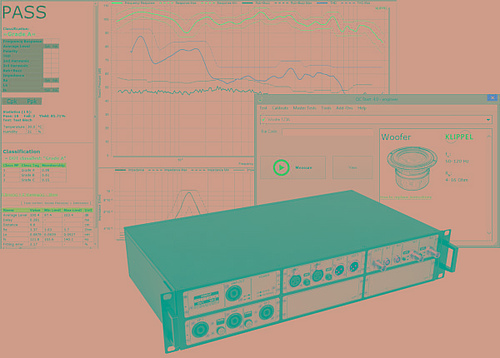QC Standard Software
The KLIPPEL QC Software in combination with the KLIPPEL Analyzer hardware is a comprehensive solution dedicated to the quality control of
- electro-acoustic transducers (e.g. micro-speakers, woofers, tweeters, microphones ...),
- passive audio systems (speaker box, headphones) as well as
- active, wireless and digital audio systems (smart speaker, Bluetooth® enabled headphones, tablets, smart phone, cars, multimedia, ...)
Video: Introduction of QC Standard Software
With loading this video, you agree that your data will be transferred to YouTube and that you have read our data protection policy.
QC Basic fulfills common demands of modern electroacoustic end-of-line testing while keeping an eye on the budget. QC Standard is based on the same software framework, enhanced by advanced features setting new standards in speaker and audio system testing.
Using KLIPPEL QC, defective units are detected reliably, even if the symptoms are not audible in a noisy production environment while focusing on the ultimate goal to increase the yield rate in manufacturing. End-of-line testing provides valuable diagnostic information for detecting the root cause of the problem and allows solving problems as soon as possible.
The KLIPPEL QC framework is highly flexible. Test sequences comprise measurement steps (tasks) with individual stimuli. This allows shortest test cycles using most critical signals for testing at the physical limits. Unique extension modules (Tasks) integrate seamlessly for advanced applications like nonlinear parameter testing or air leak detection. Additional software tools are available for data post processing, statistics, process control and much more.
The software has two basic access levels (operator and engineer). An intuitive user interface (available in different languages) and smart limit setting algorithms are implemented to shorten training and setup periods for operators and engineers.
The dedicated project management software QC Start is a simple, yet efficient software framework exclusively designed for daily QC business. It fulfills the following tasks:
- Simplify test and data management
- Simple test selection by barcode
- Define operator rights and instructions
- Synchronize multiple production lines
- Call post-processing tools
- Device setup and calibration
- Access remote online support
For special requirements, QC Standard provides a plug-in customization infrastructure to integrate tailor made features easily. This all is supplemented by a selection of hardware accessories for an all-in-one comprehensive testing solution.
From dB-Lab version 210, QC Tasks can also be used within the Klippel R&D software framework. Therefore, QC test functions can be used in R&D setups in parallel to the R&D software modules. Test sequences may contain both, R&D and QC operations.
Features and Benefits
Features
- Ultra-fast testing at physical limit
- Highly sensitive detection of defects (Rub & Buzz)
- Ambient noise detection - no false rejects
- Easy limit calculation, grading, limit import
- Dedicated for use with KLIPPEL Analyzer hardware (KA3, PA)
- Supports 3rd party audio interfaces (sound card)
- Automatic detection of "golden reference units"
- Easy test management and synchronization
- Customizable test sequences
- Production indices (Cpk, Ppk)
- Process control rules (Nelson/Weco)
- Yield and single value statistic
- Operator and engineer access level
- Auto-detection of amplifier gain
- Multi-language user interface (EN, ZH, DE, ES, PT)
- Simple integration into assembling line
Benefits
- 100% production testing
- Ensure consistency of production
- Process control
- More reliable than human ear testing
- Comprehensive defect detection
- Simple and intuitive operation
- Seamless integration in production process
- Compatible to Klippel R&D
- Flexible, modular solution to match your company needs
- Simple customization with dedicated infrastructure
Test Results
Acoustical Tests
- Frequency Response
- Windowed Impulse Response
- Average Level (Sensitivity)
- Band Levels
- Polarity
- Phase
- Spectrum
- THD
- HI-2 Distortion (add-on)
- 2nd-5th Harmonic
- Rub+Buzz (impulsive defect distortion)
- HOHD (high-order harmonic distortion)
- Incoherence
- Ambient Noise Detection
Electrical Tests
- Impedance Magnitude and Phase
- Impedance Point and Band Values
- Thiele/Small Parameters: Re, Le, fs, Qts, Qms, Qes, Cmes, Lces, Res, fb, Qb (vented box)
- Additional T/S Parameters (using added mass method or TSX add-on): Bl, Mms, Kms, Cms, Rms, Vas
Applications
- Transducers (woofer, tweeter, micro-speaker …)
- Headphones, headsets & earphones - wired, (true-)wireless, analog, digital (USB-C)
- Passive, active, digital, wireless (Bluetooth®) speakers and audio systems
- Multi-channel systems
- Amplifiers
- Crossovers
- Microphones (dynamic, condenser, MEMS)
- Incoming goods inspection
- Noise and vibration testing
Specification
QC Standard Software Package Includes
- dB-Lab
- QC Framework Module
- QC Start Tool
- QC Tasks
- db extract (data extraction tool)
- Yield Statistics (YST)
- Feature Libraries
- Software protection dongle
Supported KLIPPEL Analyzer Hardware
Additional Hardware Requirements
Optional Hardware
KLIPPEL QC Accessories (Temperature Sensor, Barcode Scaner, Manual Sweep Controller)
Multiplexer
Ear and Mouth Simulators, Head- and Earphone Test Stands
Microphone Calibrator
Professional Sound Sources
Other Versions of the QC Software
QC Basic Software
QC Tasks in R&D Framework
Related Application Notes
AN42 Tolerances of Resonance Frequeny
AN43 Data extraction and post processing
AN44 Creating automated reports
AN45 Optimal Setup for Fixed Time
AN46 Test Enclosure for QC
AN48 Yield Statistics
AN52 Result Export to VACS
AN53 Fast Quality Control of Suspension Parts
AN62 Online Input Equalization
AN64 Housing Ground Check
AN65 Linking Large Signal Testing between QC and R&D
AN73 QC Headphone Testing
AN79a Quality Control of Sound Reinforcement Equipment
General Features of KLIPPEL QC
References
W. Klippel, S. Irrgang, U. Seidel, “Loudspeaker Testing at the Production Line,” presented at the 120th Convention of the Audio Eng. Soc., Paris, France, 2006 May 20-23.
W. Klippel, U. Seidel, “Measurement of Impulsive Distortion, Rub and Buzz and other Disturbances,” presented at the 114th Convention of the Audio Eng. Soc., 2003 March 22–25, Amsterdam, The Netherlands, Preprint 5734.
Wolfgang Klippel (2011). End-Of-Line Testing, Assembly Line - Theory and Practice, Waldemar Grzechca (Ed.), ISBN: 978-953-307-995-0, InTech, Available from: http://www.intechopen.com/articles/show/title/end-of-line-testing
Patents
Germany: 102009033614; US: 8,401,823B2; China: ZL201010228820.8

